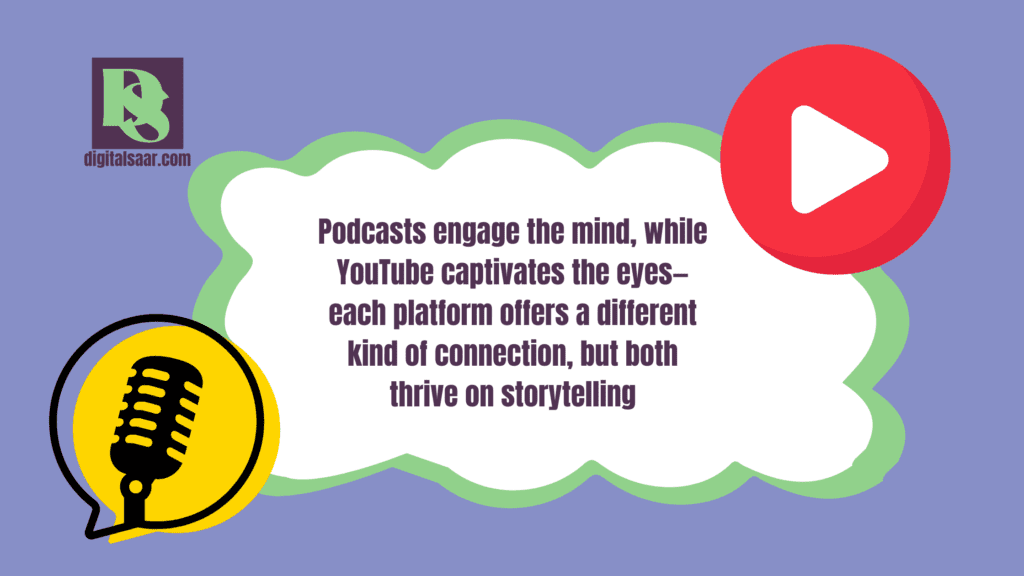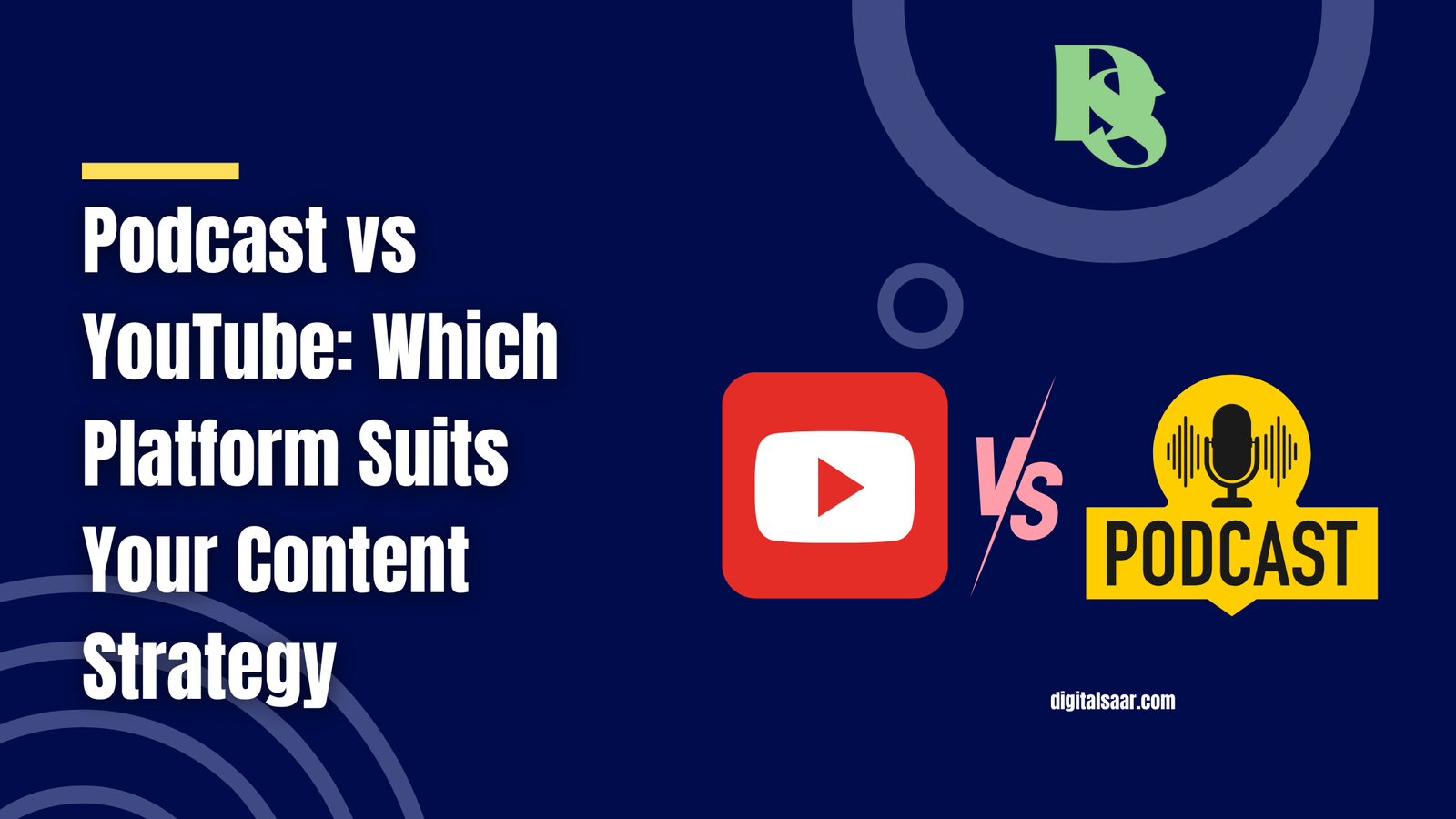In the debate of Podcast vs YouTube, content creators are often torn between these two powerful platforms, each offering unique advantages and challenges. As the digital landscape evolves, both podcasts and YouTube have surged in popularity, providing diverse ways to connect with audiences and share content. Whether you’re captivated by the intimacy of audio storytelling or the visual dynamism of video, understanding how these platforms stack up against each other is crucial for developing a successful content strategy. This guide will help you navigate the strengths and limitations of each, so you can make an informed decision about which platform aligns best with your creative goals and audience engagement strategies.
Podcast vs YouTube: Which One Should You Choose?
When deciding between Podcast vs YouTube, it’s essential to consider how each platform aligns with your content goals, audience engagement strategies, and production capabilities. Here’s an in-depth look at how these two powerful mediums stack up against each other:
Audience Engagement and Reach
- Podcasts:
- Engagement: Podcasts offer a deeply personal listening experience. They’re often consumed during daily activities like commuting, exercising, or relaxing at home. This intimacy can lead to a strong, loyal audience who values your insights and storytelling. The audio format allows listeners to engage with your content in a more focused and immersive way, without the distractions of visual elements.
- Reach: While podcasts may target a more niche audience compared to YouTube, they can cultivate a highly dedicated listener base. This focused engagement can result in a close-knit community where listeners feel personally connected to you and your content.
- YouTube:
- Engagement: YouTube’s visual and interactive features create a dynamic environment for audience engagement. Viewers can interact with your content through comments, likes, and shares, fostering a more immediate and visible community interaction. Features like live streaming also provide real-time engagement opportunities, enhancing the connection with your audience.
- Reach: YouTube’s extensive global reach offers the potential to attract a diverse and expansive audience. With its powerful search and recommendation algorithms, your content has the opportunity to be discovered by millions of users. The platform’s vast network can help you grow your audience rapidly, provided your content stands out.
Content Creation and Production
- Podcasts:
- Simplicity: Producing a podcast is generally less complex than creating videos. All you need is a quality microphone, recording software, and some basic editing tools. This simplicity allows for a focus on content rather than production intricacies. Editing typically involves cutting out mistakes, improving audio quality, and ensuring smooth transitions.
- Cost: The cost of starting a podcast is relatively low compared to YouTube. Many successful podcasters begin with minimal equipment and gradually upgrade as their audience grows. This accessibility makes podcasting a viable option for many creators who are just starting out or working with a limited budget.
- YouTube:
- Complexity: Creating content for YouTube involves more than just recording—there’s video equipment, lighting, editing software, and often a more complex production process. High-quality visuals, sound, and editing can significantly impact viewer experience and retention. This complexity requires a higher level of technical skill and often a larger time investment.
- Investment: Initial investments in video equipment and production can be substantial. However, high-quality content and professional production can set you apart from the competition and attract a larger audience. The investment also includes ongoing costs such as equipment maintenance, software updates, and possibly hiring additional help.
Monetization Opportunities
- Podcasts:
- Revenue Streams: Podcasts primarily monetize through sponsorships, listener donations, and premium content. Successful podcasters often secure sponsorship deals with brands that align with their audience’s interests. Listener support, through platforms like Patreon, can also provide a steady revenue stream. Monetizing through ads is another option, but it often requires a significant listener base to attract high-paying sponsors.
- Growth: The growth potential for podcasts lies in building a dedicated listener base and attracting sponsors interested in reaching that audience. As your podcast gains popularity, you can leverage your established reputation to negotiate better sponsorship deals and explore additional monetization avenues.
- YouTube:
- Revenue Streams: YouTube offers multiple revenue streams, including AdSense, sponsored content, and merchandise sales. The platform’s monetization options allow creators to earn from ads displayed on their videos, collaborate with brands for sponsored content, and sell merchandise directly to their audience. YouTube’s Partner Program also provides opportunities for additional income based on video performance and viewer engagement.
- Potential: With a large subscriber base and high view counts, YouTube creators can earn significant revenue. The platform’s analytics and monetization tools provide insights into performance, helping you optimize content for better earnings. Success on YouTube often translates into more significant revenue opportunities, especially with viral or high-performing content.
Discoverability and SEO
- Podcasts:
- Platforms: Podcasts are typically discovered through podcast directories like Apple Podcasts, Spotify, and Google Podcasts. Each platform has its own algorithm and ranking criteria, so optimizing your podcast’s title, description, and episode tags is crucial for improving visibility and attracting new listeners.
- Searchability: Effective SEO for podcasts involves using relevant keywords, crafting compelling episode descriptions, and engaging with your audience through social media and other channels to drive traffic. Since podcasts rely on audio alone, discoverability often depends on effective marketing and leveraging existing networks.
- YouTube:
- Searchability: YouTube’s robust search engine and recommendation algorithms make it easier for viewers to discover content. Optimizing video titles, descriptions, tags, and thumbnails can significantly improve your content’s visibility and search ranking. Engaging with trends, using keywords effectively, and creating compelling thumbnails are key strategies for increasing discoverability.
- Visibility: Consistent content production and engagement with your audience can enhance visibility. YouTube’s algorithm favors regular uploads and high viewer engagement, so maintaining an active channel and interacting with viewers can boost your content’s performance.
In summary, the choice between Podcast vs YouTube depends on your content goals, production capabilities, and how you want to connect with your audience. Each platform has its unique strengths and opportunities, making it essential to align your strategy with the platform that best suits your creative vision and business objectives.

How to Match Your Content Strategy with the Right Platform?
When discussing podcasts vs YouTube, it’s crucial to align your content strategy with the unique strengths and features of each platform. Understanding how each medium fits into your overall strategy is crucial for maximizing your content’s impact and reach.
- Determining Your Goals
- Assessing Content Goals: Start by defining what you want to achieve with your content. Are you aiming to build a loyal audience with in-depth discussions and storytelling, or do you want to leverage visual elements to captivate and engage viewers? Podcasts are ideal for those who prefer an audio-centric approach that fosters deep connections through voice and narrative. In contrast, YouTube is perfect for creators who want to combine visuals with audio to create dynamic, engaging content.
- Audience Preferences: Consider where your target audience spends their time and how they prefer to consume content. If your audience enjoys consuming content while multitasking or during travel, podcasts might be the better choice. If they prefer interactive, visual experiences and engaging with content directly on their screens, YouTube would likely be more effective.
- Matching Content Type to Platform
- Podcasts: This platform excels in delivering content that requires deep focus and reflection, such as interviews, storytelling, and educational series. If your content strategy involves providing value through in-depth discussions or creating a narrative journey, podcasts offer the intimacy and flexibility needed to achieve these goals. The audio format allows for a more personal connection, making it easier to convey complex ideas and build a dedicated listener base.
- YouTube: For content that benefits from visual representation—such as tutorials, product reviews, or entertaining skits—YouTube is the ideal platform. The visual and interactive nature of YouTube allows you to showcase products, demonstrate techniques, or create engaging stories through both video and audio. If your content strategy involves capturing attention quickly and making a strong visual impression, YouTube provides the tools to effectively convey your message.
Conclusion
In the Podcast vs YouTube debate, choosing the right platform depends on your content goals and audience preferences. Podcasts are great for deep, engaging audio content, while YouTube excels with visual and interactive experiences.
Evaluate your strategy and audience to determine which platform best fits your needs. Share your thoughts on Podcast vs YouTube in the comments and explore our resources to get started on your chosen platform.
FAQs
What’s the main difference between podcasting and YouTube content?
Podcasts are primarily audio-based and cater to passive listeners (commuting, multitasking), while YouTube is a video platform designed for visual storytelling, tutorials, and face-to-face engagement.
Which platform is better for building a personal brand?
YouTube offers more visibility and visual connection, which helps in personal branding. However, podcasting can build deep, loyal audiences through intimate, long-form conversations. It depends on how you want to connect.
Do I need expensive equipment to get started on either platform?
No. For podcasts, a decent mic and quiet space are enough. For YouTube, you can start with a smartphone camera, natural lighting, and basic editing tools. Invest gradually as your audience grows.
Which is easier to monetize—podcast or YouTube?
YouTube has more built-in monetization options (ads, memberships, Super Chat), but podcasts often monetize through sponsorships, affiliate marketing, and premium content. YouTube may scale faster with visual content.
Can I repurpose content between both platforms?
Yes! You can extract audio from YouTube videos for podcasts, or add visuals to podcast episodes for YouTube. Repurposing saves time and widens your audience reach across both platforms.
How do I decide which platform suits my content strategy best?
Consider your audience habits, content type (visual vs conversational), goals (visibility, authority, SEO), and your strengths (on-camera presence vs voice delivery). Choose based on alignment, not trend.





